|
Oven Roasts
A cut of lamb suitable for oven roasting is usually a minimum of
2 inches thick. If not overcooked, the dry heat of oven roasting
enhances the flavor and tenderness of the lamb. The best oven roasts
are from the tender cuts of the loin, rib, and leg. Shoulder cuts,
which are usually best when braised, may be purchased as oven roasts
if the cuts are from younger animals and are of the highest quality.
|
|
Blade Roast
The blade roast is cut from the shoulder blade section of the shoulder
primal. Although it is best when braised, it can be successfully
oven roasted if the meat is of the highest quality and it is not
overcooked.
|
|
Saratoga Roll
This refers to a boneless center roast obtained from the blade
portion of the shoulder and is also known as a chuck eye roast.
|
|
Arm Roast
The arm roast is cut from the upper arm section of the shoulder
primal. Like the blade roast, it is often braised, but it can be
roasted successfully if it is not overcooked.
|
|
Whole, Bone-In Shoulder Roast
One of the larger cuts of lamb, shoulder is very flavorful. Bone-in
shoulder roast, also known as square-cut shoulder, can be used in
a variety of recipes and is a more economical cut than leg of lamb.
Although many cooks believe that a bone-in roast produces better
flavor, the complex bone structure of the shoulder makes it difficult
to carve. The roast can be purchased pre-sliced and tied to hold
the shape, making carving unnecessary, but it must not be overcooked
because it can dry out more easily than a roast that has not been
presliced.
|
|
Whole, Boneless Shoulder Roast
Boned shoulder is usually rolled and tied to maintain its shape,
if it is to be roasted. This is an ideal cut for stuffing.
|
|
Rib Roast or Rack of Lamb
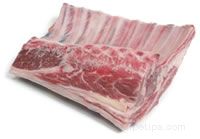
|
A whole rib roast, or "rack of lamb" has seven or eight
ribs. Although it may be roasted as is, it may also be "Frenched,"
or prepared with the upper ends of the rib bones trimmed (and often
capped with decorative covers). One rack of lamb is usually large
enough to serve three people. A rib roast is one of the most tender
and juicy cuts of lamb and it is also one of the most expensive. Roasting
is the best method for cooking a rib roast, but it should never be
overcooked because it will lose some of its tenderness. |
|
Crown Roast
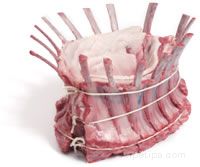
|
Two or three racks of lamb can be combined end to end and then curved
into a circle to make a Crown Roast. This is a special preparation
of Rack of Lamb and may be available from some butchers without special
ordering; or it can be created by the home cook. Be sure the chine
bone has been cut through before attempting to create the crown roast. |
|
Guard of Honor
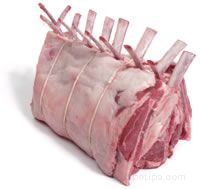
|
The bone ends of two racks of lamb can be interlaced and then tied
to form the Guard of Honor. Like the Crown Roast, this is a special
preparation of Rack of Lamb and may be available from some butchers
without special ordering; or it can be created by the home cook. |
|
Loin Roast
The entire loin section may be left whole as a bone-in roast. It
is not a large cut and should be cooked carefully to prevent overcooking
and drying out.
|
|
Loin Eye Roast
This is a boneless cut which consists of the muscle that lies along
the backbone. It makes an elegant, expensive roast but is quite
small, usually not weighing more than two pounds. The loin eye roast
is also known as the boneless loin roast, rolled lamb roast, or
a loin roll.
|
|
Saddle of Lamb
This cut is a double loin roast, from both sides of the backbone.
It does not contain a large quantity of meat, but the quality is
unsurpassed, and it is easy to carve. The cut would probably need
to be special-ordered from your butcher.
|
|
Whole Leg, Bone-in
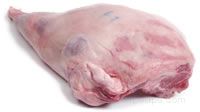
|
The whole, bone-in leg can weigh from five to nine pounds and may
be American style (no shank bone attached) or French style (shank
bone left on). |
|
Whole Leg, Boned
This cut makes a compact and tidy roast when rolled (with or without
stuffing) and tied or netted to keep its shape. It may also be butterflied
(so-called because the deboned, flattened leg resembles a butterfly's
shape) for grilling.
|
|
Sirloin Half of Leg Roast, Bone-in
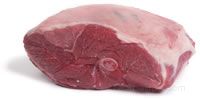
|
The sirloin (top of the leg, hip area) is meatier and more tender
than the shank half and makes an excellent oven roast. It usually
weighs 3 to 4 pounds. |
|
Sirloin Half of Leg Roast, Boneless
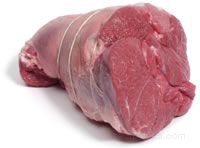
|
The sirloin half of the rear leg, when boned and rolled, makes an
ideal size (about two pounds) for four people. |
|
Foresaddle of Lamb
This cut is the entire front half of the lamb carcass, from a lamb
of about 20 pounds. It is usually stuffed and roasted.
|
|
Center Leg Roast
Cut from the center of the rear leg, the center leg roast contains
a portion of the sirloin half and a portion of the shank half of
the leg.
|
|
Baron of Lamb
This refers to the entire rear half of the lamb carcass, usually
from a lamb of about 20 pounds. It is usually roasted.
|



